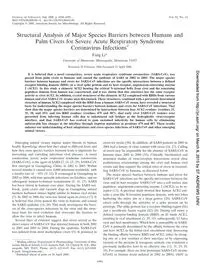
2008 Structural Analysis of Major Species Barriers between Humans and Palm Civets for Severe Acute Respiratory Syndrome PDF
Preview 2008 Structural Analysis of Major Species Barriers between Humans and Palm Civets for Severe Acute Respiratory Syndrome
JOURNAL OF VIROLOGY, July 2008, p. 6984–6991 Vol. 82, No. 14 0022-538X/08/$08.00�0 doi:10.1128/JVI.00442-08 Copyright © 2008, American Society for Microbiology. All Rights Reserved. Structural Analysis of Major Species Barriers between Humans and Palm Civets for Severe Acute Respiratory Syndrome Coronavirus Infections� Fang Li* University of Minnesota, Minneapolis, Minnesota 55455 Received 28 February 2008/Accepted 21 April 2008 It is believed that a novel coronavirus, severe acute respiratory syndrome coronavirus (SARS-CoV), was passed from palm civets to humans and caused the epidemic of SARS in 2002 to 2003. The major species barriers between humans and civets for SARS-CoV infections are the specific interactions between a defined receptor-binding domain (RBD) on a viral spike protein and its host receptor, angiotensin-converting enzyme 2 (ACE2). In this study a chimeric ACE2 bearing the critical N-terminal helix from civet and the remaining peptidase domain from human was constructed, and it was shown that this construct has the same receptor activity as civet ACE2. In addition, crystal structures of the chimeric ACE2 complexed with RBDs from various human and civet SARS-CoV strains were determined. These structures, combined with a previously determined structure of human ACE2 complexed with the RBD from a human SARS-CoV strain, have revealed a structural basis for understanding the major species barriers between humans and civets for SARS-CoV infections. They show that the major species barriers are determined by interactions between four ACE2 residues (residues 31, 35, 38, and 353) and two RBD residues (residues 479 and 487), that early civet SARS-CoV isolates were prevented from infecting human cells due to imbalanced salt bridges at the hydrophobic virus/receptor interface, and that SARS-CoV has evolved to gain sustained infectivity for human cells by eliminating unfavorable free charges at the interface through stepwise mutations at positions 479 and 487. These results enhance our understanding of host adaptations and cross-species infections of SARS-CoV and other emerging animal viruses. Emerging animal viruses impose major threats to human health. Knowledge about how they adapt to different hosts and how they cross species barriers between hosts is important for preventing and curtailing infectious viral diseases. A novel coronavirus, severe acute respiratory syndrome coronavirus (SARS-CoV), is the agent of SARS (7, 18, 23, 25). SARS-CoV first emerged in Guangdong, China, in 2002 to 2003. Within several months it caused over 8,000 infections worldwide, with a fatality rate of �10% (9, 32). It reemerged in Guangdong in 2003 to 2004, with four sporadic infections, no fatalities, and no subsequent human-to-human transmission (5, 16, 27). SARS has been absent in humans ever since. During the SARS out- break, palm civets and raccoon dogs in Guangdong animal markets harbored viruses highly similar to human viral strains (5). In 2005 to 2006 the virus was found again in civets (17). It is believed that civets passed the virus to humans and caused the SARS epidemic (14, 26). This study investigates the barri- ers of the cross-species infections by the virus and the struc- tural basis for viral evolution that overcame the barriers to allow the virus to infect humans. Several lines of evidence suggest that civets served as the direct source of SARS-CoV that infected humans in both 2002 to 2003 and 2003 to 2004. During the epidemic, SARS-CoV was isolated from most marketplace civets (5). It persisted in civets for weeks (30). In addition, all SARS patients in 2003 to 2004 had a history of close contact with civets (16, 27). Culling of civets may be responsible for the absence of SARS-CoV in humans since 2003 to 2004 (33). Critically, biochemical and structural studies of virus-receptor interactions reveal close evolutionary relationships among the civet and human viral strains and thus support the critical roles of civets in transmit- ting SARS-CoV to humans, as discussed below. The major species barriers between humans and civets for SARS-CoV infections are the specific interactions between the virus and its host receptor. SARS-CoV uses a cell surface zinc peptidase, angiotensin-converting enzyme 2 (ACE2), as its re- ceptor (13). A previous study showed that human ACE2 con- tains a claw-like N-terminal peptidase domain, with two lobes harboring the active site in a deep groove (28). SARS-CoV enters cells through the activities of a spike protein on its envelope. The spike protein has a receptor-binding region (S1) and a membrane fusion region (S2) (8). During cell entry, a defined receptor-binding domain (RBD) on S1 binds ACE2, resulting in viral attachment (1, 29, 31); subsequently, S2 fuses viral and host membranes. Which host is susceptible to SARS- CoV is primarily determined by the affinity between the virus and host ACE2 in the initial viral attachment step. Increasing the binding affinity between RBD and ACE2, either by chang- ing one or a few residues at their interface or by expressing variants of the proteins in transgenic animals, can transform a previously ineffective host to an effective one (12, 15, 19, 20, 24). For example, there are four prototypic SARS-CoV strains: hTor02 (a human strain isolated in 2002 to 2003), cSz02 (a * Mailing address: Department of Pharmacology, University of Min- nesota Medical School, 6-121 Jackson Hall, 321 Church St. S.E., Min- neapolis, MN 55455. Phone: (612) 625-6149. Fax: (612) 625-8408. E-mail:
